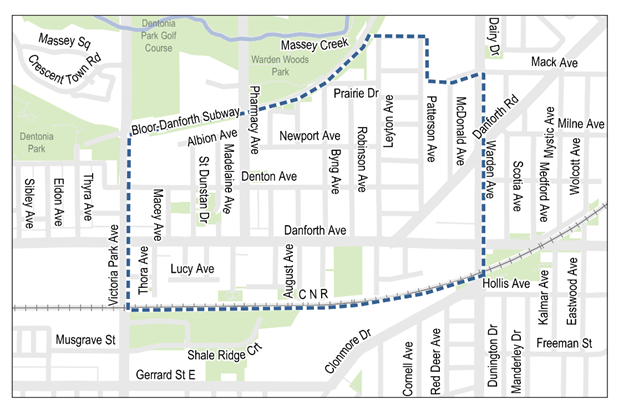
In consultation with the local community, the City is developing a Neighbourhood Streets Plan (NSP) for the Oakridge area that identifies, prioritizes and recommends short and long-term improvements to traffic operations and road design to support safety for all modes of transportation.
The Neighbourhood Streets Plan aims to address three main areas of community concern in the project area:
The project area is located between Victoria Park Avenue to the west, the Bloor-Danforth subway line, Leyton Avenue, and Burn Hill Road to the north, Warden Avenue to the east and the Lakeshore East GO rail corridor to the south.

While we aim to provide fully accessible content, there is no text alternative available for some of the content on this page. If you require alternate formats or need assistance understanding our maps, drawings or any other content, please contact us at 416-396-5785 or email OakridgeStreets@toronto.ca.
What is a Neighbourhood Streets Plan?
Neighbourhood Streets Plans (NSPs) identify and recommends traffic operations and street design measures to create safer streets in the neighbourhood.
The Oakridge Streets Plan will:
Public consultation on the Oakridge Streets Plans will take place in two phases.
The participation of local residents and community groups is essential to identifying appropriate actions and effective changes for the Oakridge neighbourhood.
NSPs will result in short-term actions (1 to 2 years) which can be made using temporary, flexible materials like signs, paint, and bollards, and will identify longer term changes which can be accomplished alongside future programmed road work.
The outcomes of each NSP will be different based on local conditions and the needs of each neighbourhood. Generally, NSPs will recommend actions related to motor vehicle speed and volume management, and traffic safety conflicts on local streets. NSP recommendations are informed by the City’s Traffic Calming Guide , Vision Zero Action Plan, and Complete Streets Guidelines. Some examples of actions that may be considered include:
The City of Toronto is inviting local residents, businesses and organizations to learn more and provide feedback on the Oakridge NSP project. Public and Interest Group opinions, along with technical and policy considerations will be used to inform City staff recommendations and decisions to be made by City Council.
The comment period for Phase 1 consultation has closed. The Phase 1 Public Consultation Report summarizes feedback received.
In this phase, the project team presented background information and consulted the community on issues commonly experienced in the neighbourhood and ideas for actions and changes.
View materials from the June 10, 2024 public drop-in event below:
See feedback received using the project’s digital interactive map.
Members of the public can continue to share comments with the team anytime using the contact information on this page.
In this phase, the project team will consult the community on proposed short-term actions (1 – 2 years) which can be made using temporary, flexible materials like signs, paint and bollards and will identify longer term changes, which can be accomplished alongside future programmed road work.
To be added to the project mailing list, please email OakridgeStreets@toronto.ca